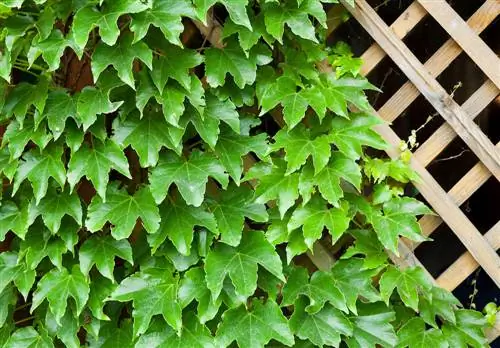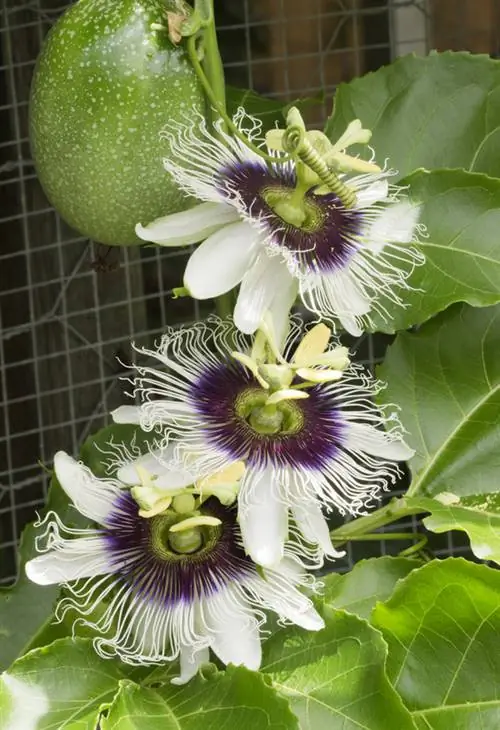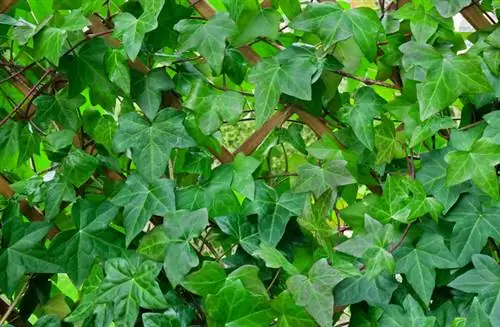- Author admin [email protected].
- Public 2023-12-16 16:46.
- Last modified 2025-01-23 11:19.
Trellises play a central role in tomato cultivation. We have selected the best climbing aids for you, from simple ropes to high-quality spiral rods. There are also practical tips for building your own.

Which climbing aids are suitable for tomatoes?
Stake shapes such as bamboo tubes, plastic, wood or spiral steel sticks are suitable as climbing aids for tomatoes. Trellises, climbing towers or pyramids are recommended for planters. Homemade trellises made of wire and rope can be used in the bed or greenhouse.
Trails in stick form
Tomato plants have no adhesive organs. To ensure that the tendrils climb up and do not grow prone on the ground, they are fixed to rods with wire, raffia, twine or clamps. The advantage is that it is easy to use. The plant stakes just have to be inserted deep enough into the ground so that they don't wobble. The climbing aids should also be able to withstand the cumulative weight as the tree grows. These plant sticks are suitable:
- Bamboo tubes with a thickness of 15 millimeters or more
- Tomato sticks made of plastic, at least 20 millimeters thick
- Wooden sticks made of oak or larch, approx. 30 millimeters thick
- Steel pipes with structured PE coating
Among the support sticks for tomatoes, spiral sticks (€29.00 on Amazon) score points with their particularly effective stabilization of the tendrils. Thanks to the twisted shape made of galvanized steel, they can be reused for many years. Slow-growing tomato varieties do not need to be tied here as long as they are regularly pinched out.
Trellis and climbing tower for tomatoes in planters
If you grow your tomatoes in a pot or flower box on your balcony, you won't be without a practical climbing aid for the tendrils. Garden retailers have a we alth of trellises, pyramids, obelisks and towers. The constructions not only serve as a useful climbing aid, but also offer a decorative appearance. Good to know that most models can also be attached later.
If you don't want to deal with the topic of trellises at all, just plant the tomatoes in a hanging basket. Choose hanging tomato varieties with small fruits and snack on them as you walk by throughout the summer.
Build your own climbing aid for tomatoes in the bed and greenhouse
Cost-conscious hobby gardeners do not invest in a ready-made trellis, but simply build it themselves in the bed or greenhouse. To do this, they use the struts of the roof structure in the greenhouse. In the open field, stable wooden posts are driven into the ground at the ends of the beds. Smaller support posts, which are screwed on at a 45 degree angle, protect against wind throw. The rest of the procedure is the same for both variants:
- Stretch a solid wire approx. 2 meters high
- Tie ropes to it, adjusted to the distance between the tomato plants
- tie the lower end of the respective rope below the first pair of leaves
Each individual rope acts as a climbing aid by guiding the main shoot up in coils. Wide raffia ribbon, soft sisal cords, Velcro fasteners, gauze bandages or old clothes cut into strips serve as binding material. It is important to note that the materials do not cut into the tomato shoots.
Tips & Tricks
Reusable trellises are dangerous breeding grounds for viruses, fungal spores and pests. It is therefore essential to disinfect them carefully before each use. Otherwise, dreaded diseases will suddenly strike, such as brown rot.






